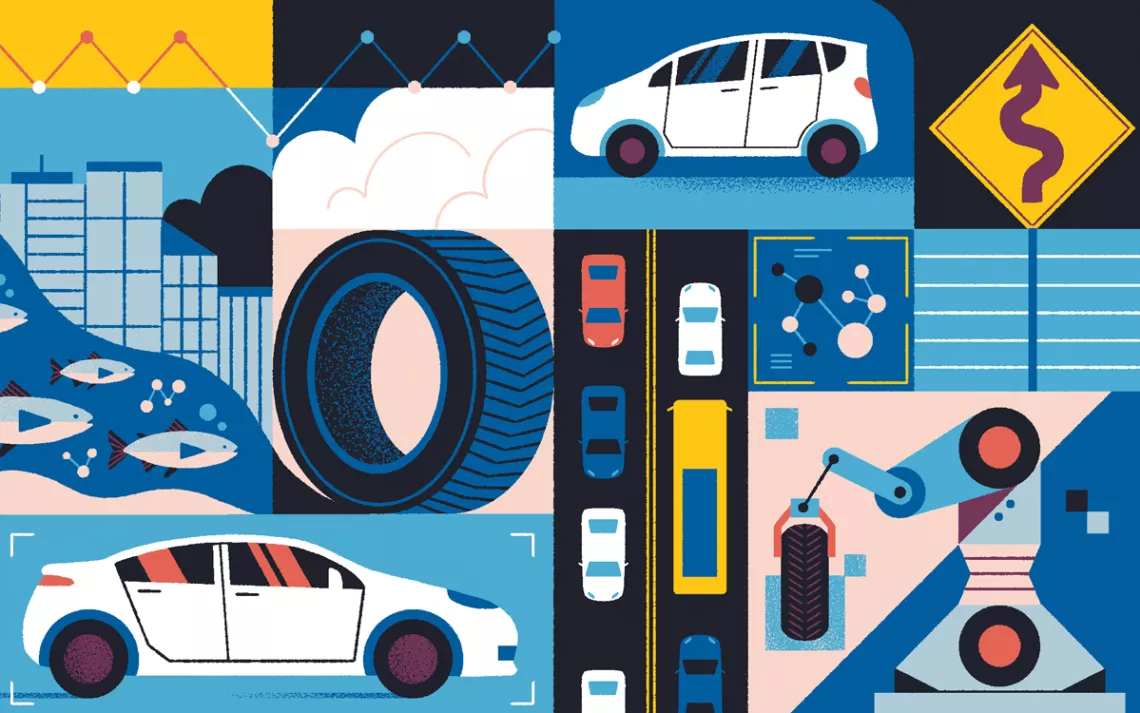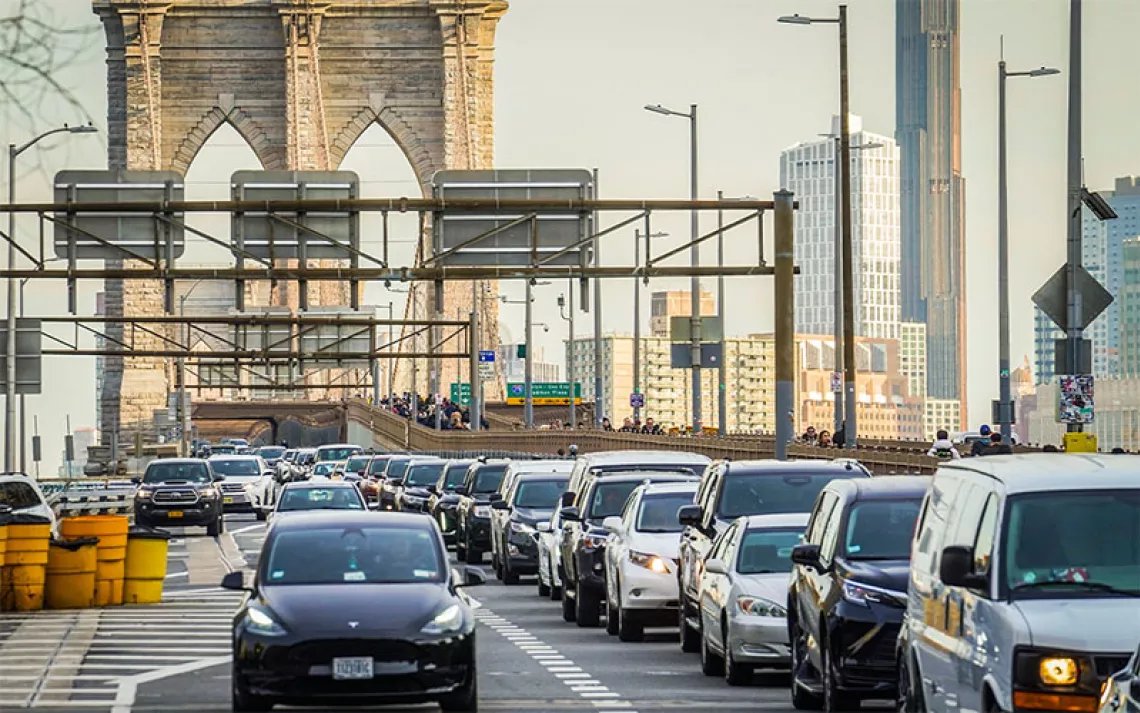Electric Big Rigs Are Poised to Revolutionize the Trucking Industry
A new generation of heavy haul vehicles will cut carbon pollution, clean up the air, and improve truckers' lives
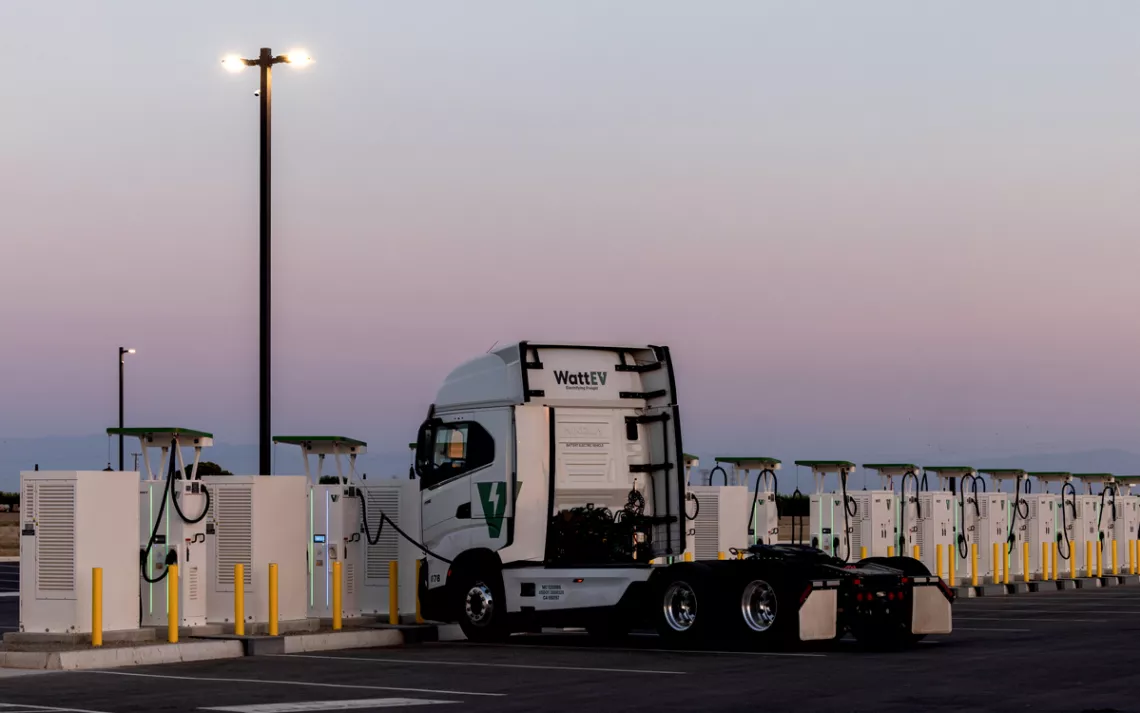
A WattEV charging facility in Bakersfield, California.
THE CHARGING YARD for electric trucks at the Port of Long Beach is bright and sunny and full of semitrailer tractors—the truncated front ends of big rigs without their big-box loads. It’s also quiet. Elsewhere at the port, wherever there are trucks, there’s the near-deafening rumble of diesel engines. But the trucks here aren’t combusting; they’re filling up with electrons to power their next trip to Southern California’s Inland Empire, the constellation of cities to the east with one of the heaviest concentrations of warehouses in the world.
To Louis Cardona, a port trucker for the past 10 years, that silence is the best part of driving an electric truck. The diesel-engine roar goes on pretty much all day because port trucking, also known as drayage, is mostly about waiting—for entry through the port’s security gates, for loads to be lowered down by towering gantry cranes from massive container ships, for traffic to move on permanently congested Southern California roads. “If you turn the engine off, it always gets really hot,” Cardona says, so it’s a choice between sweltering and enduring a noise that can exceed 100 decibels, 10 points higher than the legal limit for workplaces.
If California didn’t have grand climate ambitions, Cardona would be stuck with noisy diesel. But he now has a choice of what to drive, because state regulators decreed that by 2035, only zero-emission trucks will be allowed to work the state’s seaports. The regulation is key to California’s attempts to cut its carbon pollution. Nationally, transportation accounts for nearly one-third of carbon emissions, and heavy-duty trucking is responsible for a quarter of that, adding more than 400 million metric tons of greenhouse gases to the earth’s atmosphere every year. Trucks emit more locally damaging pollutants too, like particulate matter from their diesel engines, which infiltrates human lungs and causes a host of ailments for people in port communities. Decarbonizing freight matters more than just about anything else in the fight to stabilize the climate and protect human health.
Current electric big rigs are a move in the right direction, but they’re far from perfect. Their range is limited, and their batteries are heavy. “As a driver, you can feel the weight,” Cardona says. And managing the battery usage can “take up a lot of headspace.” Driving uphill and accelerating burns through the truck’s charge in a hurry; he’s learned to use a light foot on the accelerator and maximize coasting. (Like electric cars, electric trucks have regenerative braking, so slowing and braking recharges the battery.) When Cardona got to the Long Beach charging yard earlier in the day, he had just completed a 164-mile round trip to a warehouse and back. When he started out, the vehicle claimed that it had 289 miles of range, but when he got back, it said it only had 28 miles left. There’s a reason that truckers call onboard range estimators “guesstimators.” “I compare it to a phone,” Cardona says. “Your phone says you’ve got tons of battery life until you start watching videos.”
Such problems would be moot if batteries had more capacity and were lighter—as manufacturers say they will be in the future. Also, Cardona says, we need more chargers. The charging ecosystem “needs to be more like Tesla’s, where you have places to charge everywhere.”
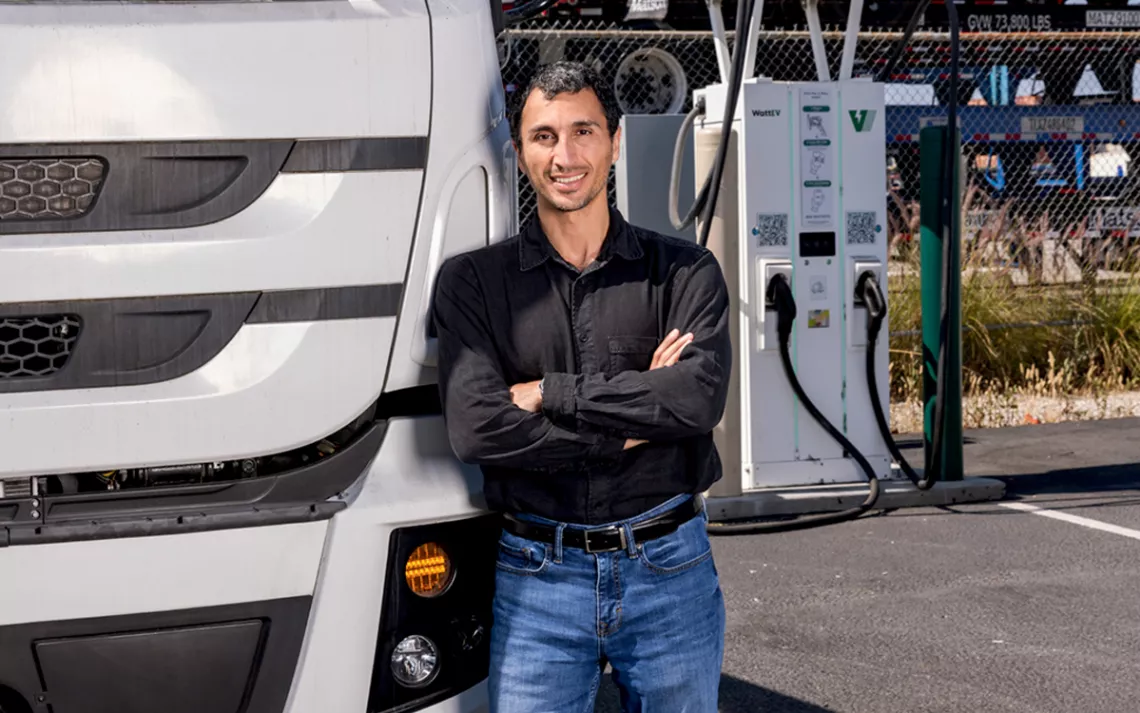
WattEV CEO Salim Youssefzadeh runs an electric-truck charging yard at the Port of Long Beach in California.
“We’re working on that for you guys,” says Salim Youssefzadeh, who is with us at the charging station. His charging station, actually, because Youssefzadeh is the CEO of WattEV, the company that leased the land and installed the chargers. Youssefzadeh has a vision for the future in which drivers like Cardona will be able to drive 500 miles, pull over and charge in 10 minutes, and then be back on the road—as quick as a diesel fill-up. Trucks with battery packs that can handle such charging speeds have yet to be made, but WattEV’s new charging yard in Bakersfield, California, already has the first operational megawatt charger in the country. Powered with solar panels and battery storage, it could fill a battery with 300 miles of range in the time it takes for a trucker to use the restroom and eat lunch. Youssefzadeh admits, “There’s still no truck that can use it.” But he’s certain one will come on the market soon, even if his company has to commission it.
WattEV was “a Covid baby,” Youssefzadeh says, founded in late summer 2020, just as California governor Gavin Newsom issued an executive order requiring that within 15 years, all new passenger cars and trucks sold in state be zero-emission. Medium- and heavy-duty vehicles had until 2045 to attain zero-emission status, but drayage trucks would follow the same schedule as new passenger cars and trucks. That got trucking company CEOs looking into the feasibility and availability of battery-electric trucks and opened the door to WattEV.
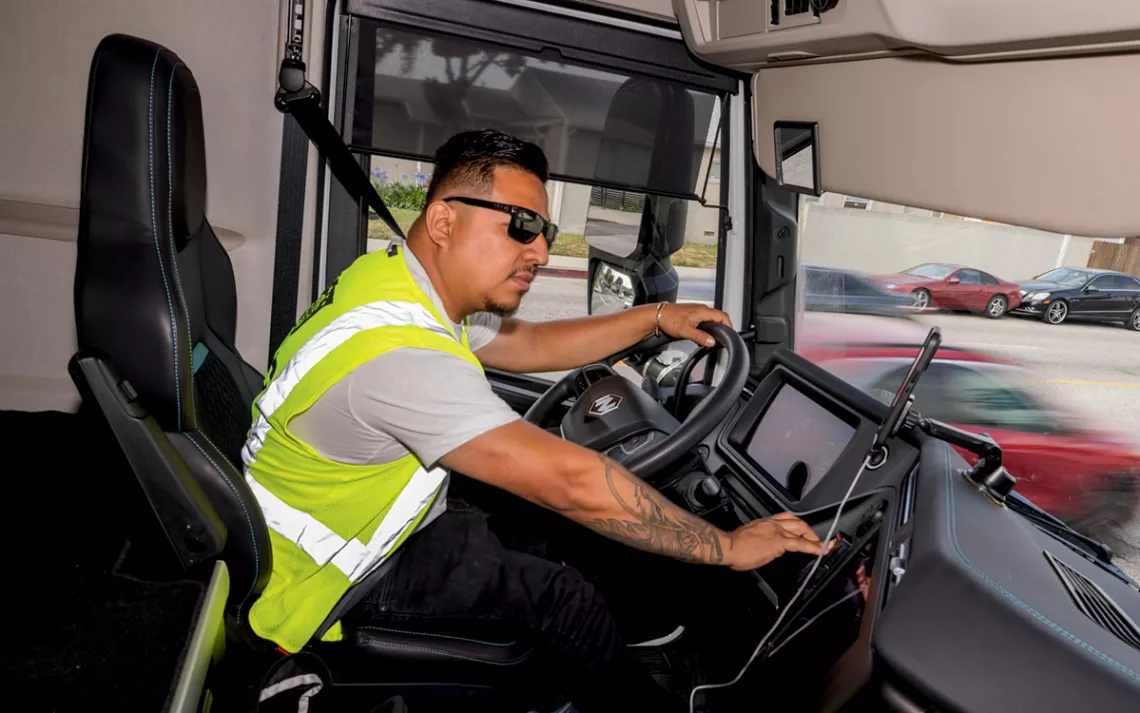
Longtime port trucker Louis Cardona is glad to see the end of diesel trucks.
Youssefzadeh was only 31 at the time and had already abandoned a couple of early experiments in the clean energy field. “The mission was to accelerate the transition,” he says. “At the time, we wanted to be the leading [charging] infrastructure providers. But we very quickly realized that it’s half the battle.” If you don’t have the trucks, chargers sit idle; if you don’t have the chargers, you can’t move the trucks. He realized that WattEV needed to do it all: Provide the charging yards, brand and offer trucks as a service, and even connect—or in some cases generate—the power.
“We’ve developed over time to be completely vertically integrated,” he says. “We do everything but manufacture the trucks.” In May, WattEV added 180 new battery-electric trucks to the 36 it already had in its fleet, making it a medium-size trucking company as well as a builder of charging networks. The idea, Youssefzadeh says, is to offer “trucks as a service.” A trucker could pull in with a run-down battery and climb into a freshly charged truck in just minutes, eliminating the charging downtime that everyone fears.
Like many transitions—from waking to sleeping, wealth to poverty, democracy to fascism—the switch from dirty to clean in the trucking business happened very slowly and then all at once.
Youssefzadeh had a hard time getting utilities to take him seriously when he first described the power demands of truck charging. WattEV was a “a start-up with zero credit saying, ‘We want 10 megawatts.’” That’s a substantial ask: Ten megawatts is enough to run 2,500 homes.
WattEV now has four such sites in addition to those in Bakersfield and Long Beach, including one in San Bernardino, an Inland Empire city with nearly 37 contiguous square miles of warehouses. Eventually, the company plans to build charging infrastructure everywhere from Otay Mesa on the US-Mexico border to Puyallup, Washington—wherever a Pacific coast truck driver might need to rest and charge up.
IF YOU'RE LOOKING to see how the transition from diesel to zero-emission trucks is taking shape, the Ports of Los Angeles and Long Beach are where it’s happening. Together, they’re known as the San Pedro Bay Port Complex—the busiest port in the western hemisphere and the 10th busiest in the world. It processes half a trillion dollars in goods every year, one-third of all US trade that moves through seaports in containers. In 2021, when consumers were shopping online in record numbers, the Port of Los Angeles alone brought in nearly $300 billion in cargo.
The price of that banner year, however, was a 56 percent increase in particulate-matter emissions and a 40 percent rise in greenhouse gas emissions. It wasn’t just from trucks; at one point in November 2021, 114 ships were backed up in the harbor, chuffing bunker-fuel soot and smoke. (They’ve since been banned from idling closer than 150 miles from shore.) But trucks are the primary reason why San Pedro Bay port communities, heavily working-class and Latino, suffer the worst diesel-particulate-matter pollution in the state.
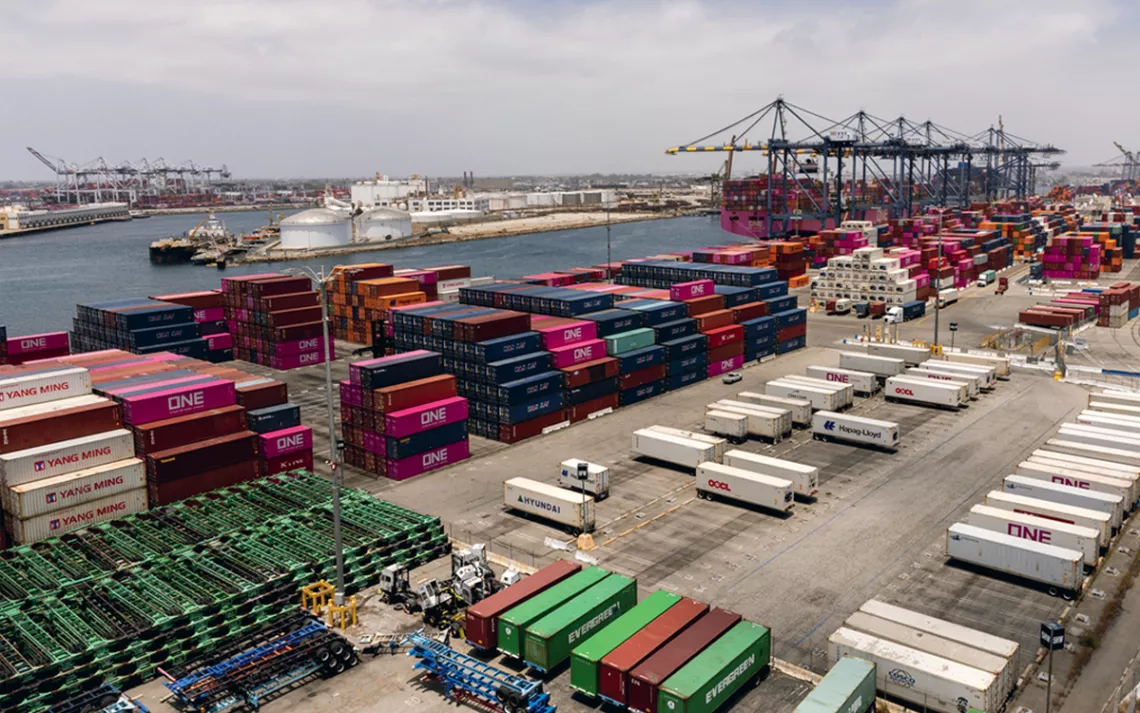
By 2035, all trucks operating at the Port of Long Beach (a.k.a. “the Green Port”) will be zero-emission models.
That’s why environmental groups working on behalf of those communities sued the Port of Los Angeles in 2001 to stop a planned expansion. The settlement they reached two years later included $50 million to mitigate the impacts of port operations. The money funded a transition to less-polluting yard equipment and shoreside electric power for container vessels, a first for any US shipping terminal, reducing air pollution from each ship by a ton per day.
Los Angeles’s sister port in Long Beach now bills itself as “the Green Port.” With its equipment and ships at berth mostly humming along on electricity instead of idling on bunker fuel—the dirtiest of dirty fuels—the port feels as though it were built as a model for the future. And clean trucks are the last, key piece of its green puzzle.
Like many transitions—from waking to sleeping, wealth to poverty, democracy to fascism—the switch from dirty to clean in the trucking business happened very slowly and then all at once. California has long required diesel-truck manufacturers to provide cleaner models for the state’s market, an effort that ramped up in 2006 with the ports’ Clean Air Action Plan. In 2008, the San Pedro Bay ports banned pre-1989 trucks and required all trucks to meet 2007 emission standards by 2012. Those two actions alone cut diesel particulate matter and nitrogen oxides, the primary component of smog, by 90 percent.
But it wasn’t enough. Emissions from the ports in general were still stifling the state’s long-standing efforts to reduce greenhouse gas emissions by 40 percent or more below 1990 levels, and diesel soot still poisoned the air in local communities. In 2017, the ports updated their Clean Air Action Plan for a second time to reflect the widening availability of zero-emission technology and began requiring it across all sectors: ships at berth, the yard equipment used to move and stack containers, trucks of all sizes, and anything else that pollutes the air at the ports. Finally in 2023 came the rule from California’s Air Resources Board requiring port trucks to go zero-emission by 2035.
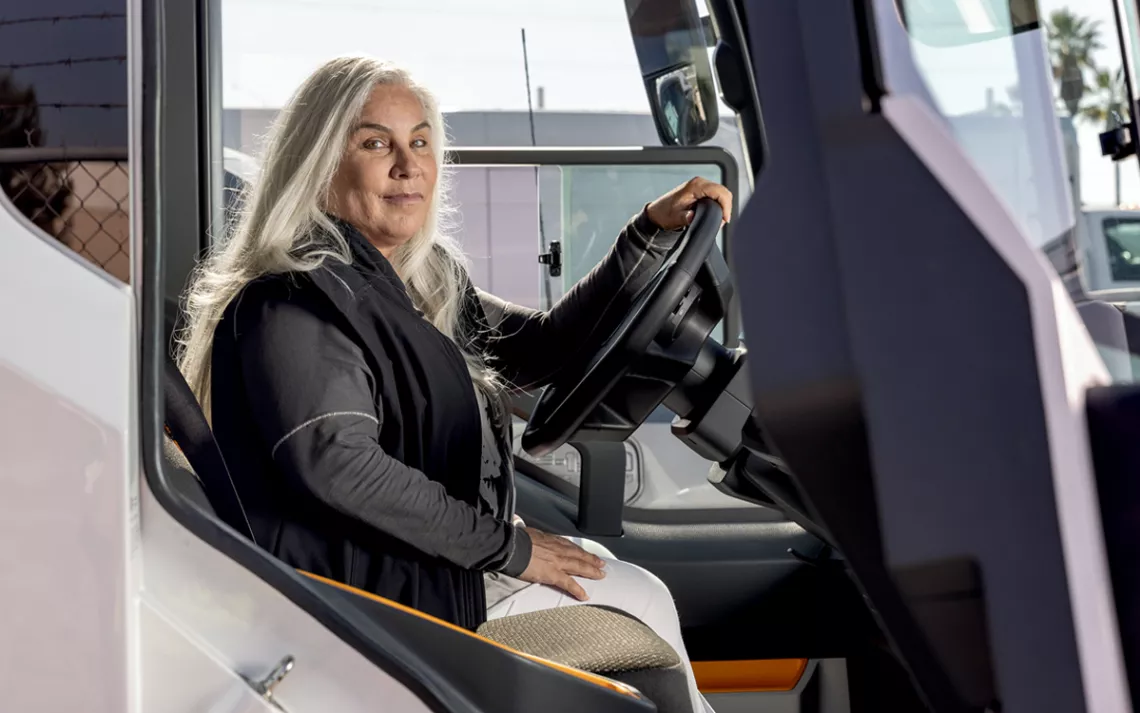
Lisa McGhee manages the zero-emission-vehicle program at Tom’s Truck Center in Santa Ana.
It was not well received by the trucking industry. Matt Schrap, CEO of the Harbor Trucking Association, an industry advocacy group, admits that trucking companies have known they have to move toward cleaner trucks. “They see the writing on the wall.” But 2035, he insists, is too soon to start banning diesel drayage trucks: “Even with the incentive money that’s out there, these [zero-emission] trucks are extremely expensive.” A new battery-electric big rig can cost as much as a half million dollars, three times as much as a brand-new diesel truck in the same category.
California does have a program for small trucking companies that will pay up to 90 percent of a truck’s cost, and the 2021 Bipartisan Infrastructure Law allocated $17 billion for ports and waterways, with $3 billion in grants for decarbonization projects. But there might still be costs government grants can’t cover. “Insurance goes up with the cost of the truck,” Schrap says. “Labor costs go up because of the decreased range,” because companies are paying drivers to sit at a charging bay. There are potential weight penalties, because batteries are heavy and trucks in California have weight limits. And when trucks have to carry less cargo to make those weight limits, those costs are passed on to the customer. Sometimes it means raising prices by 30 to 50 percent, Schrap says. “We’re just trying to think of a rational, reasonable rollout for this. But when we’re dealing with the State of California, there’s not a lot of reasonableness.”

Sign up to receive Sierra News & Views
Get articles like this one sent directly to your inbox weekly.
With this action you affirm you want to receive Sierra Club communications and may vote on policy designated by the Sierra Club Board.
California might be forcing the issue at the moment, but trucking companies will soon choose battery-electric technology voluntarily, just to save money, says Lisa McGhee. She manages the zero-emission-vehicle program at Tom’s Truck Center, a firm that sells trucks of all sorts to drayage fleets and other commercial operators. Before that, she worked for the GreenPower Motor Company and the San Diego Airport Parking Company, where she transitioned entire fleets to zero-emission vehicles way back in 2015. Her experience tells her that battery-electric heavy-duty trucks will soon dominate the market simply because, over time, they’re cheaper to operate. Electric vehicles need less maintenance, have fewer moving parts, and never need an oil change, she says, so they have less downtime and lower fuel costs. “Your operational cost per mile is half what it would be with combustion,” she says. “When you multiply that by 10 or 15 or 100 trucks, it’s persuasive.”
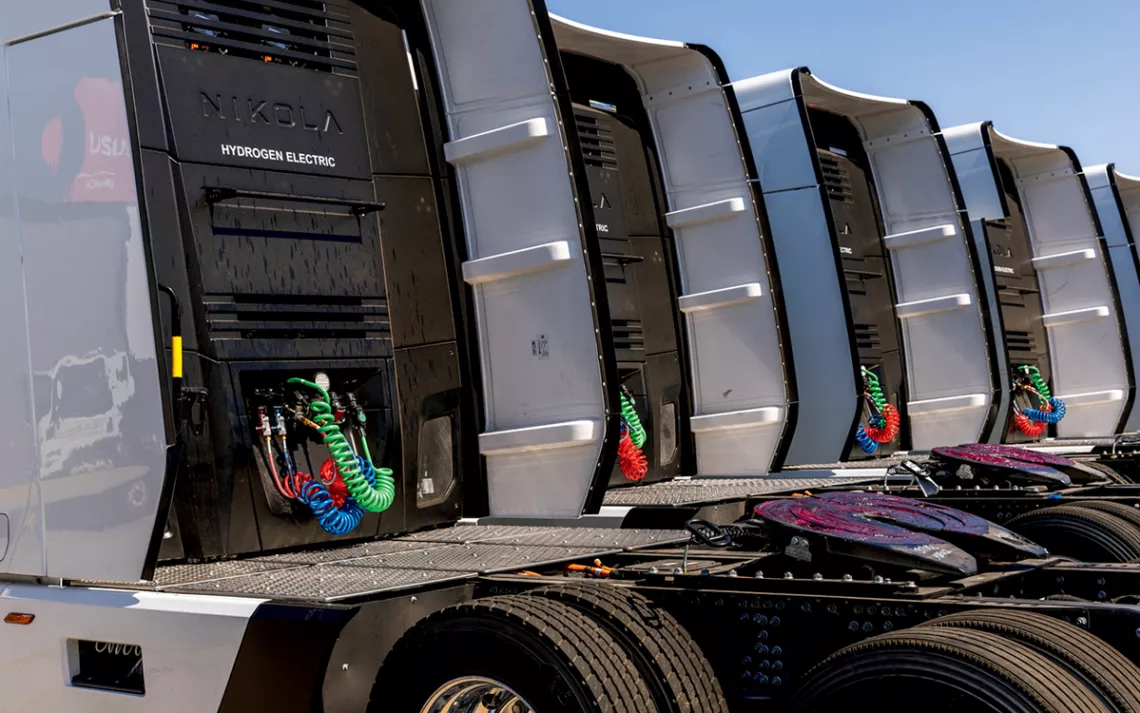
New on the scene are hydrogen-electric trucks.
As for labor costs, she doesn’t see a problem with paying drivers an hourly wage while they charge their vehicles, because drivers need breaks anyway. Two 125-mile round trips from the ports to the warehouses leave plenty of free time to plug in and charge up, she insists. “It’s like eating lunch or eating dinner, right? You say, ‘I don’t have time to do it.’ But you do, and I can show you where in your day you do.”
Youssefzadeh also presumes that people will choose electric trucks, so long as they have the means to charge them. He isn’t counting on state and federal grants, although he’s managed to secure his share of them, along with two visits to the White House to present his vision of the clean trucking industry. WattEV has leased its EV trucks to Walmart and Procter & Gamble, “which is a huge source of revenue for us,” he says. Even without California’s mandate, those companies “have sustainability goals that they want to meet, and they’re willing to have their loads moved with zero emissions if it’s close to what they were already doing with diesel trucks.” In a way, WattEV is a corporate pilot program. “They start moving freight within our network that we know works.” From there, he trusts that other operators will follow suit. “We like to move fast and solve problems.” There are problems aplenty to solve. California will need upward of 100,000 new chargers to keep the estimated 160,000 battery-electric trucks running and the electricity to keep them operating. Few in the industry dispute that it can be done, but many insist that it can’t be done in a decade.
California already requires manufacturers of vehicles to phase in zero-emission technology if they want to keep selling in the state—and in the 10 other states that have adopted California’s rules. By 2028, 50 percent of new vehicles sold in California need to be zero-emission, including heavy-duty trucks. “Once we see that shift, we won’t have as many choices,” McGhee says, because you can’t drive what isn’t manufactured. “The technology is moving forward with or without you.”
WHEN I NEXT got in touch with Louis Cardona a few weeks after meeting him in the WattEV charging lot, he had a new story to tell: “I’m not driving battery-electric anymore. I’ve switched over to hydrogen.” Cardona’s boss, Jim Gillis of IMC Pacific, had just purchased a small fleet of new hydrogen-fueled trucks to test, and Cardona loved the one he was driving, manufactured by a new Phoenix–based company called Nikola. He liked it because he didn’t have to worry about range quite as much. Although hydrogen fueling stations aren’t common, by carefully managing the truck’s regenerative braking, maintaining certain speeds, and accelerating gradually, Cardona can drive the truck up to 500 miles and refuel in less than half an hour.
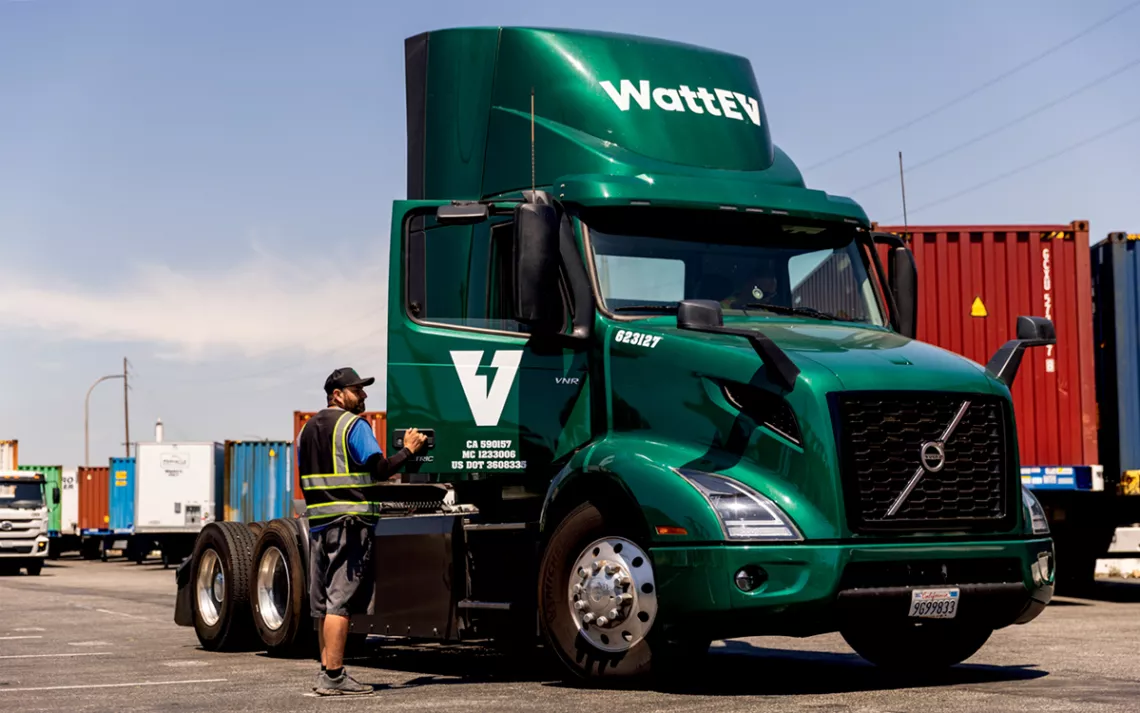
For now, hydrogen-electric trucks are easier to charge than battery-electric models.
IMC is a major employer for truckers, with more than 500 drayage trucks operating at the ports. “We’re taking a blended approach,” Gillis said when I interviewed him at his Compton office. “We deployed the battery-electric trucks, put them through the paces, looked at their strengths and weaknesses. And there was a gap.” The gap was the range issue.
On a cool, Compton “May gray” day, I climb into a Nikola Tre FCEV (hydrogen-fuel-cell EV) truck tractor with Khari Burton, a former trucker who now works for IMC training drivers how to handle the new trucks. The ride is high: It takes limber hamstrings and upper body strength to pull yourself up the three steep steps into the cab. But once inside, you don’t want to leave. The headroom, the sleeping berth, the elegantly designed controls all give off an air of futuristic glamour—not something a port trucker typically enjoys. “It’s the Bentley of trucking,” Burton says. “It’s probably—no, not probably—it is the most comfortable ride that I’ve ever had.”
The fuel-cell truck is quiet like battery-electric ones, Burton says, which is great except that, “sometimes when you line up to pick up a load, you have to honk to let them know you’re there. They’re used to hearing the diesel engine pull up.”
Hydrogen-fuel-cell trucks are widely viewed as zero-emission, and the federal government subsidizes them as such. In October 2023, seven hydrogen production facilities were rewarded with $7 billion from the Bipartisan Infrastructure Law, and the industry qualifies for production tax credits included in the Inflation Reduction Act. But aside from what emits from the tailpipe, which is famously mostly water vapor, hydrogen as it’s currently produced is still pretty much a climate and public-health disaster. Hydrogen takes more energy to produce than it yields, and currently there’s no way to bring the fuel to market at scale without contaminating local air and emitting greenhouse gases. Making enough hydrogen to power 150,000 trucks in the state would likely zero out the gains California has made in transitioning to electric power generation.
Nor is green hydrogen a profitable venture, at least not yet. Youssefzadeh made a run at making hydrogen with solar in the Mojave Desert before he started WattEV, but acquiring the amount of land he would have needed was too daunting. He couldn’t make it work economically.
Meanwhile, battery technology is improving, and battery prices are coming down. It’s possible to imagine, five or 10 years from now, vehicle batteries light enough so they won’t limit the weight of the cargo a trucker can haul. And charger networks like the one planned by WattEV will put range worries to rest. Once everyone knows the benefits of driving an electric truck, McGhee says, “they’ll all be believers.”
 The Magazine of The Sierra Club
The Magazine of The Sierra Club

